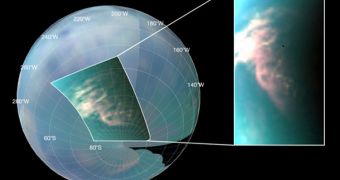Given the tremendous similarities that exist between Earth and Saturn's largest moon, Titan, experts are comparing the two in order to determine how the environment on extrasolar planets may look like. They are also trying to understand what ingredients are necessary for the development of life.
While they are many things separating the two objects – such as for example average temperatures, atmospheric compositions, the tidal forces they're subjected to, and the cycles they undergo – there are also many things that Earth and Titan share in common.
Perhaps the most important one is the prebiotic nature of the moon's atmosphere. It contains everything needed for the development of primitive life except liquid water molecules. However, the role of water is taken on by liquid hydrocarbons such as methane and ethane in all other aspects.
Titan's atmosphere is based entirely on such chemicals. The cycles that are powered by water here on Earth – including rain – use hydrocarbons on the Saturnine moon. Lakes at the celestial body's north and south poles are made of liquid methane and ethane, not water.
In fact, at temperatures of minus 193 degrees Celsius, ice is as hard as granite. However, the most important question remains – could life develop in Titan's atmosphere without the presence of water?
Many chemists appear to think that this is indeed possible. They classify the moon as a “Life could happen!” environment, which makes it one of only a handful of such places other than Earth. The others include the Saturnine moon Enceladus and Jupiter's Europa.
“One of the things that attracts me about Titan is that it has a lot of the same circulation features as Earth, but done with completely different substances that work at different temperatures,” explains Ray Pierrehumbert, the Louis Block Professor in geophysical sciences at the University of Chicago.
“The ironic thing on Titan is that although it's much colder than Earth, it actually acts like a super-hot Earth rather than a snowball Earth, because at Titan temperatures, methane is more volatile than water vapor is at Earth temperatures,” he explains.
At this point in time, experts are introducing every bit of data Cassini sends back into dedicated computer models, whose main goal is to simulate how the moon's atmosphere functions. In recent times, scientists found out that Titan can produce lightning strikes from its clouds.
What is becoming increasingly clear is that a dedicated mission needs to be sent to Titan with the express goal of searching for organic molecules and signs of primitive life. If there is any other body in the solar system that can support life other than Earth, this is it, Daily Galaxy reports.

 14 DAY TRIAL //
14 DAY TRIAL //